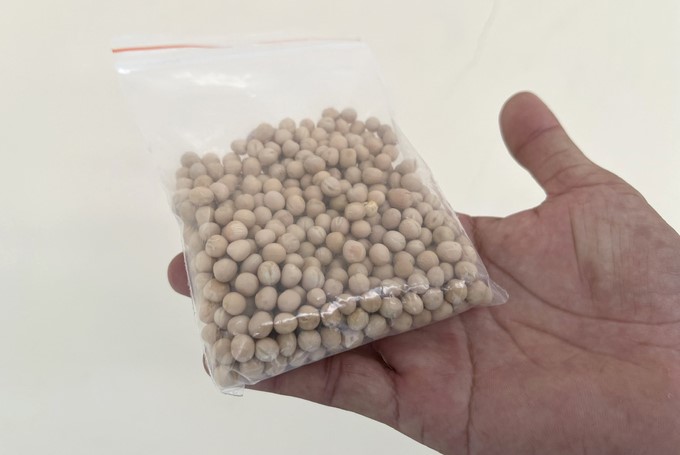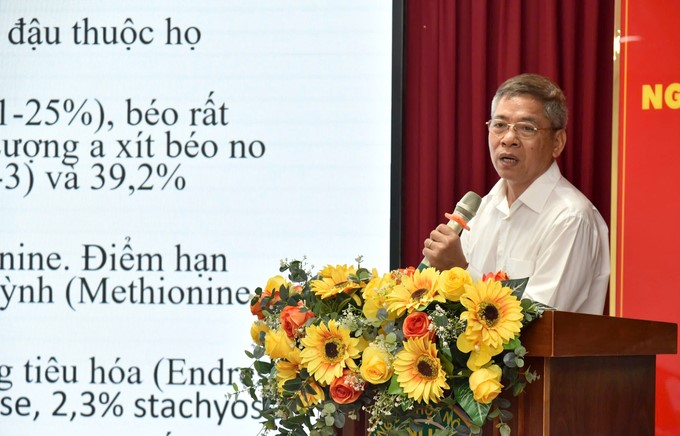November 28, 2025 | 01:23 GMT +7
November 28, 2025 | 01:23 GMT +7
Hotline: 0913.378.918
November 28, 2025 | 01:23 GMT +7
Hotline: 0913.378.918

Canadian peas. Photo: Son Trang.
Ration is one of the main causes of greenhouse gas emissions in livestock production. Therefore, improving rations is one of the important solutions to reduce emissions in livestock production. Of which, the greatest potential for reducing emissions in terms of improving rations is in three livestock species, including dairy cows, beef cattle, and buffalo.
For pigs and poultry, if the ration can be improved by using emission-reducing animal feed ingredients, it will also have a certain significance in reducing the overall emissions of the livestock industry. That is because pigs and poultry are key livestock, with a large herd in Vietnam's livestock industry.
One of the solutions to reduce emissions from animal feed that is being mentioned by many experts is to replace some animal feed ingredients with other ingredients that both ensure livestock efficiency and have low emissions.
At the workshop "Sustainable Livestock in Vietnam: Experience and Solutions from Saskatchewan, Canada," organized by Nong Lam University-Ho Chi Minh City, Dong Nai Livestock Association, and Saskatchewan Vietnam Office (under the Consulate General of Canada in Ho Chi Minh City), Canadian peas have been introduced as a source of animal feed rich in nutrients and emission-reducing.
According to Dr. William W. Riley, technical consultant of the Canadian Bean Association, Canada has a large bean production area, reaching 1.2 million hectares by 2023 with an output of 2.6 million tons. Canadian peas are a moderate source of both protein and energy, making them a suitable ingredient in most cattle, poultry farming, and aquaculture programs.
Canadian peas have proven to be economically effective and can be used to replace soybean meal in broiler, laying hen, duck, and pig farming in many countries. In Vietnam, Dr. La Van Kinh, Vice President of the Vietnam Animal Feed Association, conducted research on using Canadian peas on porkers.

Dr. La Van Kinh reported on the results of research on using Canadian peas on porkers in Vietnam. Photo: Son Trang.
Research results show that fattening pigs that eat rations containing Canadian peas instead of soybean meal with the same balance of amino acids will have the same weight gain, feed intake, feed conversion coefficient, carcass components, and meat quality in all experimental batches.
Using Canadian peas at a rate of up to 32% in the ration still gives good results. When the price of Canadian peas is 1/2 the price of soybean meal, the economic efficiency is very clear, saving 7-15% of food costs. Particularly, compared to popular plant feed ingredients such as corn, wheat, barley, soybean meal, and canola meal, Canadian peas have the lowest greenhouse gas emissions.
According to Dr. Steven Webb, Global Institute for Food Security (University of Saskatchewan), Saskatchewan and Canada (on average) always have the lowest greenhouse gas emissions when including changes in the amount of CO2 in soil because agricultural soil here has net CO2 storage, while all other countries have net CO2 emissions.
Canadian beans, wheat, and yu choy seeds produced in Saskatchewan all have much lower CO2 emissions during farming than in other countries. For example, bean farming in the US has CO2 emissions that are 561% higher than the Canadian average, while emissions from Canadian bean farming in Saskatchewan are 62% lower than the Canadian average.
Minimizing the use of the plowing method is one of the important solutions to help the farming of beans and many other crops in Saskatchewan in particular and Canada in general have very low emissions.
Dr. William W. Riley said that because ration is responsible for a large portion of total emissions in animal feed, Canadian peas should be used in animal feed to replace sources of ingredients with higher carbon footprints, such as cereals and oilseed meal. From there, reduce greenhouse gas emissions in meat products. This is in line with the goals of the Vietnamese Government and livestock businesses for Net Zero.
Reducing emissions is one of the solutions to bring sustainable development to the livestock industry. According to Dr. Le Quang Thong, Head of the Faculty of Animal Husbandry and Veterinary Medicine, Nong Lam University-Ho Chi Minh City, livestock production is contributing 27% of Vietnam's agricultural GDP. Vietnam's livestock industry has been developing rapidly in recent years and plays an increasingly important role in food security. Therefore, an issue targeted in the livestock industry is sustainable development.
“Using Canadian peas in animal feed not only helps reduce emissions for livestock production in Vietnam but also diversifies the supply of animal feed ingredients. Thereby minimizing supply risks when there are adverse fluctuations in price, market, logistics, etc. in the context that Vietnam's livestock production is still largely dependent on imported animal feed ingredients," shared Mr. Nguyen Tri Cong, Chairman of the Dong Nai Livestock Association.
Translated by Thu Huyen

(VAN) According to Mr. Vo Minh Thanh, Director of the Tay Ninh Department of Agriculture and Environment, Resolution 57 has created a new development pathway for the locality, shifting from traditional toward modern agriculture.
/2025/11/26/4909-2-154329_878.jpg)
(VAN) Pearl grouper farming in HDPE cages not only delivers economic efficiency but also contributes to protecting the environment, creating jobs, and promoting marine-based experiential tourism.

(VAN) The model of making a living under the forest canopy through the agroforestry system in Van Son commune, Bac Ninh province, is expected to generate an annual income of approximately VND 30 million/ha.

(VAN) Many enterprises in Can Tho are harnessing natural energy and reducing greenhouse gas emissions in their production processes, thereby contributing to the promotion of a sustainable green transition.
/2025/11/24/3536-2-112800_176.jpg)
(VAN) Dong Nai now has tens of thousands of hectares of forests certified for sustainable management, and this area will continue to be expanded in the coming period.

(VAN) Vinh Ha hamlet (Dai Xuyen commune, Hanoi) is shifting away from small-scale farming as households adopt bioscurity into their breeder chicken models.

(VAN) Heavy rains make aquatic species more vulnerable to disease. Proactive water management and high-tech systems help farmers prevent outbreaks and protect yields.